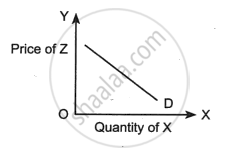Advertisements
Advertisements
Question
The demand of a commodity, when measured through the expenditure approach, is inelastic. A fall in its price will result in : (choose the correct alternative)
(a) No change in expenditure on it.
(b) Increase in expenditure on it.
(c) Decrease in expenditure on it.
(d) Anyone of the above.
Solution
Decrease in expenditure on it.
Demand for a good is termed inelastic through the expenditure approach when a fall in its price will result in the decrease in expenditure on it. This is because the expenditure is positively related with a price.
APPEARS IN
RELATED QUESTIONS
Compare inelastic demand with perfectly inelastic demand.
Give reason or Explain the following statement :
Demand for habitually used goods is inelastic.
Define or explain the following concept :
Effective demand .
State whether the following statement is True or False :
Demand for necessary goods is inelastic.
Write whether the following statement is True or False:
Demand curve has a positive slope.
Fill in the blank with appropriate alternatives given below:
When less is purchased at the constant price, it is called _______ in demand.
State whether the following statement is TRUE and FALSE
Quantity demanded varies directly with price.
Define or explain the following concept:
Direct demand
Give reason or explain the following statement.
Demand curve slopes downward from left to right.
State whether the following statement is True or False:
Demand for luxurious goods is elastic .
If the income of a consumer increases, discuss briefly its likely impact on the demand for a inferior good, Good X.
Which of the following points relates to the transaction demand for money?
Identify the correct pair of items from the following Columns I and II:
| Column I | Column II |
| (1) Budget Line | (a) Normal goods |
| (2) Bajra | (b) Inferior goods |
| (3) Consumer equilibrium | (c) Luxurious goods |
| (4) Elastic Demand | (d) M = Px*x + py*y |
Which of the following statements is true?
Aggregate demand can be decreased by:
Which of the following statements is false?
The demand curve of a firm under monopoly is ______
Read the case study and answer the questions 97 to 100:
The Coca-Cola Company is an American multinational beverage company, with its headquarters in Atlanta, Georgia. The first company that conducted its operation in the soft drink industry was Coca-Cola. It is the world's largest non-alcoholic beverage company serving more than 1.8 billion consumers daily in more than 200 countries. It has a portfolio of more than 3,500 (more than 800 no or low-calorie) products. However, the company is best known for its flagship product Coca-Cola which was originally intended to be a patented medicine invented in 1886 by pharmacist John Smith Pemberton in Columbus, Georgia. The Coca-Cola products can be termed as normal goods and in August 2019 Coca-Cola introduced a new product into the market, that is, zero sugar where the demand has increased for the product in the market.
According to the council of the Australian Food Technology Association and Institute of Food Science and Technology, the Australian nonalcoholic beverages industry has been growing steadily, with a 2.3 percent increase in overall production in the year 2000 which amounts to 2.25 billion liters. However, in the re~ent years, sales of customary carbonated soft drinks have dropped as more and more customers become health conscious and move away from high-calorie sugary drinks. Soft Carbonated drinks. and other alcohol-free beverage manufacturers have also sensed the effects of intensifying competition from private-label soft drink makers. Nevertheless, sales of greater value energy and sports drinks have driven profit generation in the industry.
The demand. for coca-cola has ______
Read the case study and answer the questions 97 to 100:
The Coca-Cola Company is an American multinational beverage company, with its headquarters in Atlanta, Georgia. The first company that conducted its operation in the soft drink industry was Coca-Cola. It is the world's largest non-alcoholic beverage company serving more than 1.8 billion consumers daily in more than 200 countries. It has a portfolio of more than 3,500 (more than 800 no or low-calorie) products. However, the company is best known for its flagship product Coca-Cola which was originally intended to be a patented medicine invented in 1886 by pharmacist John Smith Pemberton in Columbus, Georgia. The Coca-Cola products can be termed as normal goods and in August 2019 Coca-Cola introduced a new product into the market, that is, zero sugar where the demand has increased for the product in the market.
According to the council of the Australian Food Technology Association and Institute of Food Science and Technology, the Australian nonalcoholic beverages industry has been growing steadily, with a 2.3 percent increase in overall production in the year 2000 which amounts to 2.25 billion liters. However, in the re~ent years, sales of customary carbonated soft drinks have dropped as more and more customers become health conscious and move away from high-calorie sugary drinks. Soft Carbonated drinks. and other alcohol-free beverage manufacturers have also sensed the effects of intensifying competition from private-label soft drink makers. Nevertheless, sales of greater value energy and sports drinks have driven profit generation in the industry.
What has happened to the demand of zero sugar carbonated drinks?
The figure given below shows the relation between the quantity demanded for the good X and the price of the good Z. What type of goods are X and Z?

